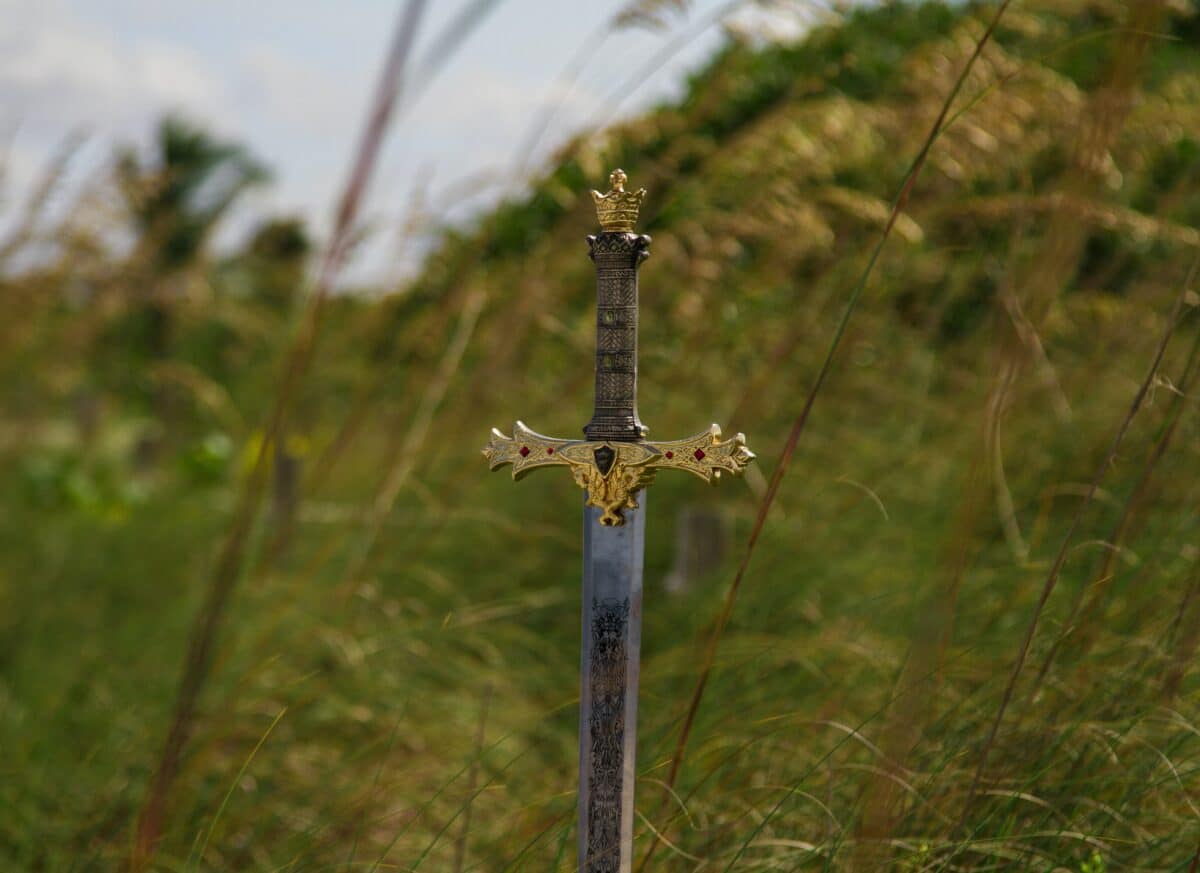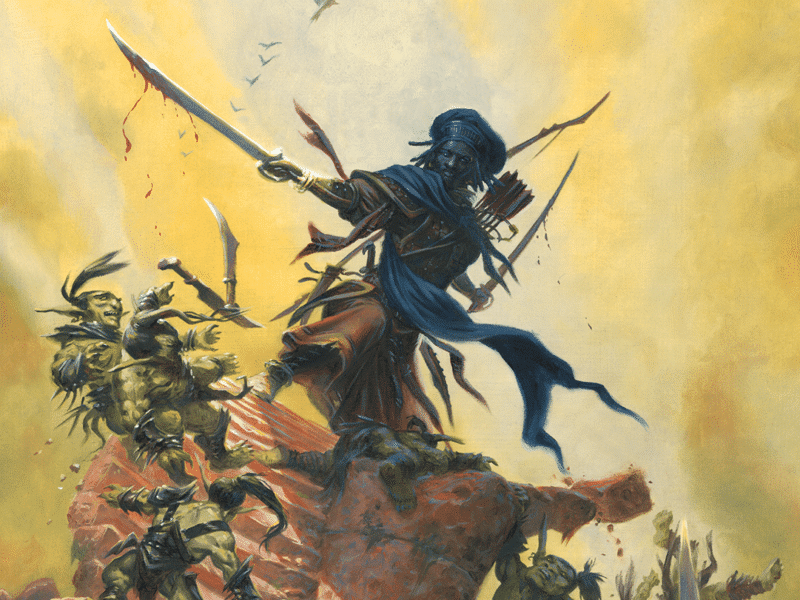Magic items are central to D&D in more ways than one. Their technical benefits in the game are manifold: they enable the adventurers to overcome foes that are far more powerful than they are, survive in adverse environments, escape threatening situations and perform astonishing feats, such as flying or turning invisible. In terms of adding atmosphere, they form an important distinction between the real world and the imagined setting in which the players’ characters dwell and go on quests. Lastly, magic items also affect storytelling in that they enable narratives to revolve around critical and miraculous objects that the characters must find, retrieve, use, protect, or even destroy.
Yet in a roleplaying game, a magic item is never more astonishing than the words that are used to describe it. This is true for the description of the item’s physical attributes, such as its design, colours, weight and general feel, as well as the abilities and powers of the item – both the abstract and tangible ones.
First impressions last
Let’s imagine that you are the DM and have homebrewed a finely crafted and arcanely enhanced masterpiece of a longsword. The characters come across this blade along with some other loot deep in a dank cave after a long and exhausting battle against a group of horrible trolls. As the characters search the cave, they find a mound of grimy coins and a longsword. One of the characters moves to pick up the coin and the sword to add them to the group’s burgeoning sack of loot.
In one scenario, the narration of this scene could sound something like this:
The player: “I run over to get the valuables!”
The DM: “Cool, you scoop up the coin and the sword. What’s next?”
The player: “Neat! Let’s move away from the cave and take a short rest so that I can examine the sword more closely.”
The DM: “You find that you’ve acquired a total of twenty-three gold pieces. You also notice that the sword is a Longsword +1.”
The Player: “Perfect! I could use another magic blade. Let’s move on – I’m sure there are more trolls about!”
Now, as an experiment, let’s treat the narration of this discovery slightly differently:
The player: “I run over to get the valuables!”
The DM: “You lean down and begin to scoop up the filthy coins and put them in your sack. You notice that the longsword is almost completely covered in grime, but there’s a reddish gleam from what looks to be a gem on its crossguard. You also realise that the blade is quite long and slim for a longsword.”
The player: (Pauses briefly) “A gem, huh? I pick up the sword.”
The DM: “As your hand brushes against the hilt of the sword, a faint jolt travels up your arm. It is as if the blade responds to your touch. At the same time, a soft wind blows through the cave system and causes the cobwebs around you to tremble.”
The player: “Whoa! What’s going on here? We need to investigate this sword straight away.”
The DM: “You take a short rest in the cave to study the weapon. When you wipe off the grime, you find that its elegant blade is incredibly sharp and engraved with thorned dark red vines, its grip is made from carved dark wood, and the golden crossguard is fitted with small cut rubies, four on each side. When you swing the sword, it feels remarkably well-balanced and light, and you accidentally cut right through a thick branch without much effort. As before, the sword seems to hum gently in your hand when you wield it, as if it were charged with a weak electrical current. Near the base of the pommel is a barely visible inscription that includes a year and a name. They mean nothing to you, but a bard might know more. In terms of bonuses, the sword provides you with a +1 bonus on attack and damage rolls.”
The Player: “This is just awesome! I bring the sword and make sure that it’s within easy reach. Let’s go on a hunt!”
The DM: “For more trolls?”
The player: “For a bard!”

This is just a simple example of how much difference some preparatory work can do when presenting the adventurers with magic items – suddenly, they become the focus of everyone’s attention, and bring a sense of mystery and real fantasy to the scene.
Here follows a list of tips for how you can make your magic items stand out and be memorable:
This thing sure looks the part!
One of the key aspects is the item’s visual appearance – in other words, what does it actually look like. You’re usually aiming to make it different to regular items of the same kind, so try to come up with aspects that will make your object stand out a little. Start with the item’s basic properties, such as the size and overall shape, and add details as you go along. The internet is your friend here, and a quick search for images can provide a wagon’s load of inspiring artwork.
It’s good to keep in mind that more isn’t always better, as an item that’s gilded literally to its hilt and adorned with all types of decorations can easily sound overly gaudy or even ridiculous. What’s more effective are a small number of distinct facets, such as an unusual core design, a strange inscription, odd-looking materials, or a handful of peculiar runes. There could also be light effects or even sounds, frequent or rare, faint or blatant.
Likewise, it’s worth remembering the dramatic importance of strong contrasts: an item that looks very mundane – such as a golden ring – but is revealed to hide immense powers has a special and often ominous feel to them.
This thing has a history
A surefire way to generate interest in a magic item is to write a background for it that’s both compelling on its own and interwoven with the setting. Simply having a history about its creation makes an object more intriguing, and if the tale is filled with mystery and excitement, then all the better. Similarly, the very making of the item can have great dramatic appeal: perhaps the enchanted hammer was forged in a cursed smithy, or maybe the dragon-shaped medallion that enables you to fly was crafted in a long-lost temple at the peak of a mountain. This history should ideally be easy to find out about – perhaps there’s a learned member of the party who knows a few snippets or the entire story (players whose characters are proficient in history usually love when they get to use the skill to shine!).
Of course, it’s also perfectly possible for an item not to have a known story but still be interesting, perhaps through its ambiguous features (strange runes flickering deep inside a dark orb, strange whispers sounding from a curved dagger, and so on). You can then run an adventure to have the characters find out where and how the item was made!
This thing does a lot!
Another simple but equally effective method for making magic items more appealing – and versatile, too – is to let them be more complex. When you are preparing your next campaign, I would recommend that you consider ignoring all the “simple” magic items in the core rulebooks, and rework them to have more flair and variation. This is because there’s no need to limit the complexity of an item’s magic properties other than to keep them simple. On the contrary, tweaking their statistics can make for items that are more flexible and original.
Let’s take a standard Longsword +2, which provides its wielder with the bonus on attack and damage rolls. What if the sword was exceedingly sharp but not overly well-balanced, and therefore grants a +3 bonus on damage rolls but no bonus on attack rolls? Or what if it is no sharper than a nonmagical blade, but well balanced and also sporting flames rolling along its blade, so that it grants a +2 bonus on attack rolls and an additional 1d4 fire damage? You see what I’m getting at here – the possibilities are endless! And we haven’t even started to look at other kinds of benefits, such as resistances, better damage (or a higher chance to hit) when fighting certain creatures, and so on. Was it a notorious barbarian’s weapon? Maybe it improves the Rage ability! Did the sword belong to a famed knight? Perhaps it’s designed to rend shields and shatter armour!
This thing’s really my style
Ensure that the magic items in your campaign are meaningful. This can be done in many ways, but there are two major aspects: the item should be at least remotely useful to one or more characters (or an NPC), or it should drive the story. A magic item that is fascinating to look at and bestows an owner with impressive powers can still end up being sold at the village fair ten minutes later if the group already possesses several near-duplicates, or if it requires attunement by an evil creature and all the adventurers are benevolent heroes.
In other words, if the group has access to a veritable armoury of enchanted weapons, don’t throw in yet another Handaxe +1. So keep track of what items the group have, and if possible, let new ones have functions that aren’t covered by those already present among the characters.
An exception is of course items that are meant to incentivise the characters in other ways, such as objects that are central to the quest. It might be a sentient skull with nightmarish abilities that must be destroyed, a sacred bronze orb that has to be found and secured, or a crystal ring that the characters must protect while transporting it across unsafe lands.
This point is closely related to another important detail when choosing what items to give the characters: remember that magic items made for utility rather than combat can be extremely powerful. While magic longswords, warhammers and battleaxes might be the hallmark of D&D, and certainly hugely appreciated by the players given that most adventures include combat, there’s a wealth of other items that can help the characters complete parts of quests in different ways. Some items enable the users to become invisible or move silently, which can do away with the need for bloodshed altogether. Other items, such as potions or things that enhance the characters’ speed or dexterity, may not be weapons but can still be great for triumphing in a fight.
This thing’s not working!
Traditionally, magic items are often resilient and never rust or break. However, this is just convention – there’s nothing that says magic items can’t be very fragile and easily break. Reasonably, this would depend on the item – there is no sense in crafting a warhammer that shatters on impact – but a gem, statuette, orb, or wand could be extremely delicate and disintegrate if it’s subjected to a blow. Or perhaps it’s flammable or unable to withstand freezing temperatures? This idea is a little controversial, but it is likely to make your players value their magic items much more, and it also makes the item different to most of those found in the core rulebooks.
On a similar note, an item can be permanently restricted to just a few uses. In other words, it won’t ever recharge: once its last use has been spent, the item turns into dust, catches fire and burns to a cinder, or just vanishes to the sound of distant laughter.
Yet another variation on the same theme is magic items that take a toll when they’re used. For example, an enchanted bow might enable phenomenal shots twice per day, but also siphon an archer of energy by draining them of hit points or make them suffer levels of exhaustion when the bow’s special powers are called upon.
I don’t want this thing…or do I?
Let magic items complement – or challenge – the player’s vision of their character. What if your flawlessly good-natured paladin comes across a beautiful magic two-handed sword that seems to be the ideal weapon for them, but after a while turns out to hide a dreadful secret? Perhaps the blade is possessed by a clever and wicked spirit that slowly but surely tempts the paladin to ever darker deeds – while it also is proving invaluable in combat and has a few redeemable traits? Suddenly, the paladin, always a class that risks being one-dimensional unless one adds a few tweaks, is turned into a conflicted person with a real challenge to manage.
These are but a few ideas that hopefully will help to inspire you when designing your next homebrew magic item. Only your imagination sets the limit of what’s doable, so fire up your coffee machine and prepare to dream up a treasure that your players’ characters will keep for a long time!







